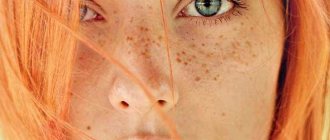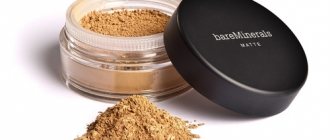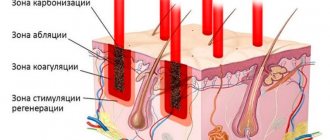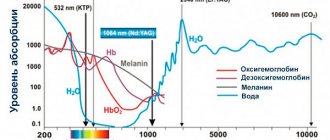Acne (blackheads) - symptoms and treatment
Acne is an inflammatory disease of the sebaceous glands and hair follicles.
Our skin has three layers:
1. top layer - epidermis;
2. middle layer - dermis;
3. underlying layer - hypodermis (subcutaneous fat).
The epidermis itself consists of several layers, the uppermost of which is called the horny layer, consists of dead corneocyte cells and performs a protective function.
The dermis is the most important layer of the skin; it is where the entire “life” of the skin is maintained. The dermis is intertwined with blood vessels and full of nerve endings. It is here that the main cells - fibroblasts - are born and work for the beauty of our skin. In addition, the dermis contains sebaceous and sweat glands, as well as hair follicles.
The hypoderma consists of loose connective tissue and fat cells - adipocytes. The thickness of subcutaneous fat depends on its location on the body and nutrition.
Of greatest interest to us are the sebaceous glands, skin appendages that are located in the dermis.
The sebaceous glands produce sebum, which is what shines so treacherously on the skin of the face, especially in the forehead, nose and chin, the so-called “T-zone”. This type of gland is hormone dependent. Sebum production occurs under careful multi-level control, which involves:
- hypothalamus;
- pituitary;
- adrenal cortex and gonads.
Hormones and their role in the development of acne
Any hormonal surge causes the sebaceous glands to actively secrete sebum.[2]
Seborrhea is a skin disease that is manifested by pathological activity of the sebaceous glands. The clinical manifestations of seborrhea are that one can observe enlarged pores, gaping or clogged with comedones, oily or dry peeling, and greasy hair. With such active production of sebum, a change in its composition occurs; laboratory studies revealed an excess amount of androgens and a reduced content of estrogens. Also, the amount of linolenic acid in sebum decreases - this helps to increase the alkaline level of the skin, disrupt barrier properties and multiply microorganisms on its surface.[3]
What microorganisms cause acne
Among the causes of acne, the first place is occupied by changes in the microbial flora of the skin. When examining the isolated microbial flora in patients with acne, a large number of anaerobic lipophilic corynebacteria, aerobic micrococci bacteria and gram-positive rods are found.
Three microorganisms take part in the inflammation process:
- corynebacterium (Propionibacterium acnes);
- cocci (Staphylococcum epidermidis);
- lipophilic fungi (Pityrosporum ovale et orbiculare).
The leading role in triggering the inflammatory process is played by Propionibacterium acnes, which produces various enzymes, including lipase. This enzyme is capable of damaging the follicle wall from the inside. The role of the immune system cannot be excluded, a decrease in the function of which is a favorable factor for the proliferation of P. acnes. A key role in the occurrence of acne is played by the hormonal status of the patient, namely hyperandrogenism - an increase in male sex hormones (testosterone and dihydrotestosterone). The sebaceous glands have certain receptors that are sensitive to androgens. Accordingly, when the level of these hormones increases, the sebaceous gland begins to pathologically actively produce sebum. In addition, the causes of acne on the face can be attributed to a hereditary factor.
Other causes of acne
All of the above etiological factors can be attributed to endogenous causes of acne , that is, having an internal nature. As for exogenous causes influencing the occurrence and development of the disease from the outside, these, first of all, include exposure to sunlight. With active insolation, skin immunity is significantly reduced, which, again, is a favorable factor for the proliferation of P. acnes.[1]
One of the reasons for the spread of acne recently is the fashion for fitness and sports, and here we cannot fail to mention bodybuilders. Due to their high-calorie diet and intake of anabolic steroids and testosterone derivatives, they are at risk for developing acne on the face, taking these drugs without consulting a doctor and taking into account the real indications for use, namely for gaining muscle mass. Taking anabolic steroids leads to sharp activity of the sebaceous glands in both men and women, even if there have been no skin problems in the past. Subsequently, various forms of acne can be observed, from acne vulgaris to conglobate forms of acne. In addition to the acquired disease, women may experience a deepening of their voice, male-pattern hair growth, and disappearance of menstruation. In men, the concentration of sperm in the seminal fluid decreases. The first point in treatment in this case will be the abolition of testosterone derivatives and anabolic steroids.[3]
Newborn acne
In the first three weeks after birth, acne occurs in 20% of newborns [7]. In infants, it appears as inflammatory papules on the cheeks and nose and closed comedones. The rash occurs due to a hormonal crisis or excessive secretion of testosterone during the prenatal period. The hormonal crisis is caused by a sharp decrease in estrol in the blood of newborns in the first weeks of life.
Acne can also appear when the mother takes systemic glucocorticosteroids in the last trimester of pregnancy.
Newborn acne goes away within a few weeks or months, so it rarely requires treatment. In this case, scars, as a rule, are not formed.
Non-inflammatory forms of acne
Non-inflammatory acne vulgaris* are comedones, which come in several types 97:
- Microcomedones. Detected by histological analysis, they are the precursors of comedones.
- Whiteheads*. These are closed comedones in which the hair follicle is filled with compact material. Can transform into inflammatory rashes.
- Open comedones. They are also called blackheads. They appear due to blockage of pores with residues of cosmetics, horny scales, and sebum. They turn black when melanin oxidizes.
There is also a form of acne called microcysts or macrocomedones. They not only cause aesthetic discomfort, but can also become inflammatory. 97
Diet
The effectiveness of correcting a healthy diet has not been proven by clinical trials, there are no refutations. In case of severe inflammation, it is recommended:
- limit the consumption of whole fat milk and easily digestible carbohydrates as much as possible;
- reduce to a minimum the consumption of sausage products, canned food, drinks with a high sugar content, sweets, cakes, fatty cakes, mayonnaise, cheese;
- minimal consumption of caffeine and strong tea;
- bakery products.
The presence of an inflammatory process in the stomach requires immediate nutritional correction by an experienced nutritionist.
Subcutaneous acne on the chin: causes
Acne is a multifactorial disease that can occur for many reasons4,50:
- hormonal disorders;
- stress;
- genetic predisposition;
- problems with the gastrointestinal tract;
- taking certain medications (GCS, anabolic steroids, etc.);
- excess in the diet of sweets, fatty foods, dairy products, foods rich in iodine, bromine, gluten;
- use of cosmetics with comedogenic ingredients, etc.
Subcutaneous acne on the chin in women may appear before menstruation, which is associated with changes in hormonal levels.
Complications
Ignoring the treatment of stage 2-3 acne is a pathology. Consequences:
- rapid expansion of pores;
- formation of post-inflammatory pigmentation;
- pronounced erythema spots;
- manifestation of milia;
- scarring, atheroma.
In cosmetology education – post-acne.
The sebaceous glands activate the function of subcutaneous sebum. Rapid accumulation of sebum in the sebaceous glands. The appearance of stretch marks, the formation of hypertrophy.
Pigment spots are malfunctions in the pigment formation process. Consequences of active insolation during the development of a chronic disease, active squeezing, increased level of trauma.
Erythema formations of spots. The appearance of pimples in problem areas. An alternative name is a stagnant spot. Formation due to disruptions in blood circulation during severe inflammatory processes.
Milia are neoplasms of round capsules with a high content of natural sebum. Localization is superficial. Under the epidermal film, often on the eyelids, around the eyes, in the temporal region, lower part of the face. Mechanical removal.
Scar formations appear in complex forms of development of common pathology. Damage to the perifollicular dermis is observed.
Diagnostics
If signs of acne occur, you should consult a dermatologist or dermatocosmetologist. The doctor will not only evaluate the number of elements, their nature, location and the presence of signs of post-acne, but will also clarify the patient’s dietary habits, whether close relatives have suffered from similar acne on the face, and a number of other points. In general, acne can be diagnosed and its severity determined at the first consultation, since the disease has a specific clinical picture.
But in order to choose the optimal treatment tactics, you need to accurately determine the cause of acne development and assess the general condition of the body. For these purposes, patients are prescribed:
- UAC;
- OAM;
- blood chemistry.
Identifying the cause of acne is extremely important, as it is a chronic disease. Therefore, in the absence of control, it can recur at any time when favorable conditions are created.
When diagnosing post-acne, the nature of facial skin changes, the presence of scars, their shape, depth, localization, and ability to smooth out when the skin is stretched are also assessed.
Severe forms of acne
There are special forms of acne, which are characterized by aggressive and severe course:
- Conglobat. Severe chronic form of acne, which is characterized by granulomatous inflammation and the formation of cysts, nodes, and abscesses. After resolution, retracted and keloid scars form.
- Fulminate. It is characterized by a severe course and an acute febrile reaction. Often, acne elements transform into ulcers, during the healing of which granulations are formed.
There are also inverse acne*, represented by papules and pustules with purulent contents, which often have an unpleasant odor.
How to choose skin care products for acne-prone faces
Care cosmetics for problem skin should contain a number of active ingredients that will help normalize the functioning of cells and saturate them with all the necessary nutritional compounds. The composition must contain sebum-regulating components. These are active compounds that reduce sebum production and make the skin less oily.
If you are looking for cosmetics to care for skin with acne and pimples, choose products with anti-inflammatory ingredients. To eliminate acne, you need to soothe skin irritation and reduce redness; it is important that the product contains antibacterial compounds to stop the development of inflammation.
For what forms of acne does a doctor prescribe topical therapy?
For severe forms of acne, doctors usually recommend systemic therapy, and for mild to moderate acne, topical therapy is more often prescribed. Clindovit® gel is a topical antibiotic that is used to treat acne (acne vulgaris)6. The main component of the drug is clindamycin6. It exhibits antibacterial activity against propionibacteria6. Clindovit® also helps reduce the level of free fatty acids on the skin6. It is recommended to be combined with the use of benzoyl peroxide or azelaic acid (Azelik® gel) to reduce the risk of developing antibiotic resistance28.











